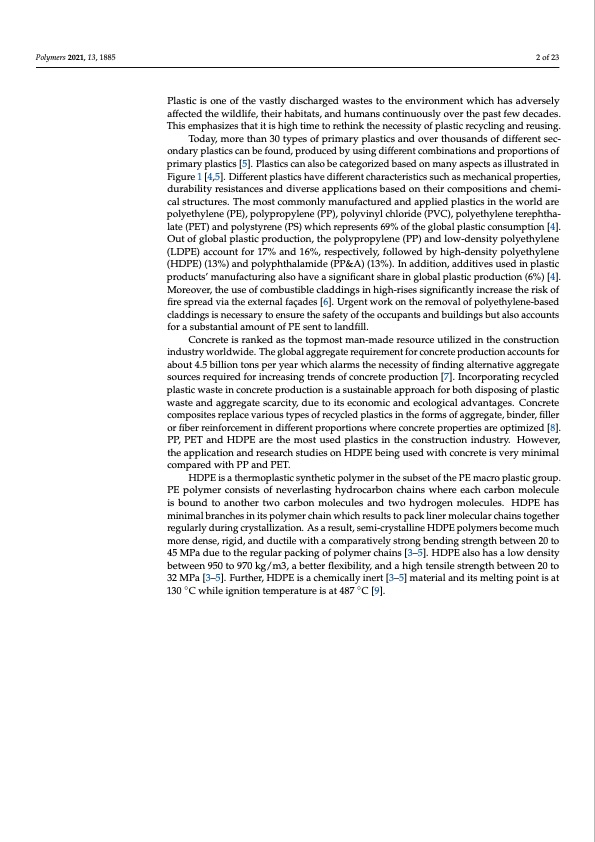
PDF Publication Title:
Text from PDF Page: 002
Polymers 2021, 13, 1885 2 of 23 Plastic is one of the vastly discharged wastes to the environment which has adversely affected the wildlife, their habitats, and humans continuously over the past few decades. This emphasizes that it is high time to rethink the necessity of plastic recycling and reusing. Today, more than 30 types of primary plastics and over thousands of different sec- ondary plastics can be found, produced by using different combinations and proportions of primary plastics [5]. Plastics can also be categorized based on many aspects as illustrated in Figure 1 [4,5]. Different plastics have different characteristics such as mechanical properties, durability resistances and diverse applications based on their compositions and chemi- cal structures. The most commonly manufactured and applied plastics in the world are polyethylene (PE), polypropylene (PP), polyvinyl chloride (PVC), polyethylene terephtha- late (PET) and polystyrene (PS) which represents 69% of the global plastic consumption [4]. Out of global plastic production, the polypropylene (PP) and low-density polyethylene (LDPE) account for 17% and 16%, respectively, followed by high-density polyethylene (HDPE) (13%) and polyphthalamide (PP&A) (13%). In addition, additives used in plastic products’ manufacturing also have a significant share in global plastic production (6%) [4]. Moreover, the use of combustible claddings in high-rises significantly increase the risk of fire spread via the external façades [6]. Urgent work on the removal of polyethylene-based claddings is necessary to ensure the safety of the occupants and buildings but also accounts for a substantial amount of PE sent to landfill. Concrete is ranked as the topmost man-made resource utilized in the construction industry worldwide. The global aggregate requirement for concrete production accounts for about 4.5 billion tons per year which alarms the necessity of finding alternative aggregate sources required for increasing trends of concrete production [7]. Incorporating recycled plastic waste in concrete production is a sustainable approach for both disposing of plastic waste and aggregate scarcity, due to its economic and ecological advantages. Concrete composites replace various types of recycled plastics in the forms of aggregate, binder, filler or fiber reinforcement in different proportions where concrete properties are optimized [8]. PP, PET and HDPE are the most used plastics in the construction industry. However, the application and research studies on HDPE being used with concrete is very minimal compared with PP and PET. HDPE is a thermoplastic synthetic polymer in the subset of the PE macro plastic group. PE polymer consists of neverlasting hydrocarbon chains where each carbon molecule is bound to another two carbon molecules and two hydrogen molecules. HDPE has minimal branches in its polymer chain which results to pack liner molecular chains together regularly during crystallization. As a result, semi-crystalline HDPE polymers become much more dense, rigid, and ductile with a comparatively strong bending strength between 20 to 45 MPa due to the regular packing of polymer chains [3–5]. HDPE also has a low density between 950 to 970 kg/m3, a better flexibility, and a high tensile strength between 20 to 32 MPa [3–5]. Further, HDPE is a chemically inert [3–5] material and its melting point is at 130 ◦C while ignition temperature is at 487 ◦C [9].PDF Image | Engineering Performance of Concrete Incorporated with Recycled HDPE

PDF Search Title:
Engineering Performance of Concrete Incorporated with Recycled HDPEOriginal File Name Searched:
6b2d9750f7cf13ccb459f476e519aec39ce1.pdfDIY PDF Search: Google It | Yahoo | Bing
Development of a solar powered Electric Ship The Electricship website originally started off as a project to develop a comprehensive renewable, affordable, modular electric ship... More Info
Modular Boat Hull Composite The case for a unsinkable, modular composite hybrid boat hull... More Info
MS Burgenstock Hybrid Electric Catamaran Lake Lucerne Unique shuttle servicing Lucerne to the Burgenstock Resort... More Info
Ground Power Unit GPU Powered by Lithium Ion Batteries The goal of the Ground Power Unit is to provide a readily accessible, modular, ready-to-power solution for remote power... More Info
| CONTACT TEL: 608-238-6001 Email: greg@electricship.com | RSS | AMP |